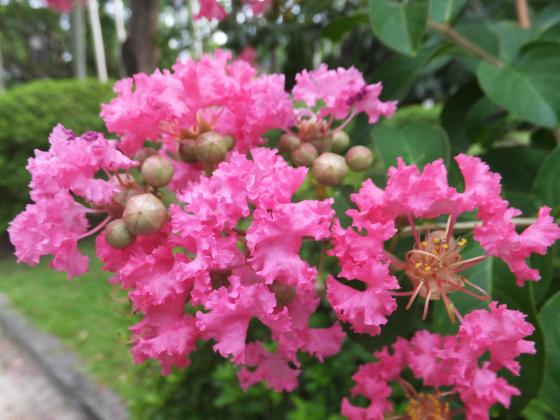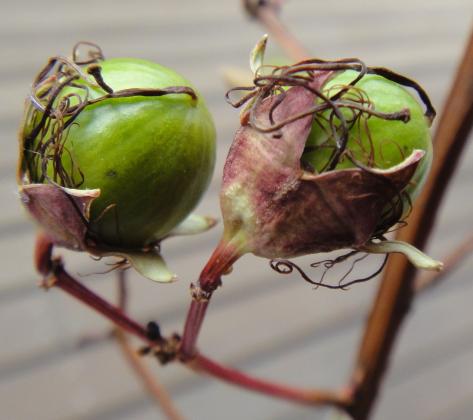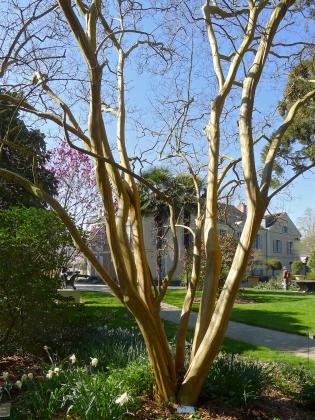Lagerstroemia - Official State Shrub of Texas
Lagerstroemia spp., crape myrtle, crepe myrtle or crapemyrtle are beautiful trees found in the warm climates of the southern U.S. It’s a relatively small graceful tree with attractive exfoliating bark in colors from pinkish gray to cinnamon. It often has multiple trunks that are smooth once the bark has peeled away.
It has white to pink to deep purple to dark red ruffly, delicate blooms clustered in panicles. In Grimes County the trees are usually from 8 to 30 feet. The opposite leaves are about 2 to 8 inches long and may change color in autumn. The fruit is a capsule that changes from green to dark brown. Seeds are small. Crapemyrtle flower buds and seed pods look similar but the flower bud is softer.
There are more than 50 species of Lagerstroemia. L. speciosa and L. indica are common in our area of Texas. The genus is named for the Swedish merchant Magnus von Lagerström who, in the 18th century, supplied Carl Linnaeus the plants used in his studies. Linnaeus created our modern system of naming organisms by genus and species called binomial nomenclature.
There were two accepted spellings for the common name, crepe myrtle and crape myrtle. Crepe was named for the crinkly crepe paper that the flowers resemble. Crape represents the English pronunciation. Because the plant resembles “real” myrtles, in the Myrtus genus, it got the species name myrtle. But people thought crepe or crape myrtle was a type of “real” myrtle. So, plants in the Lagerstroemia genus were changed to crapemyrtle, one word. Many sources have all three versions. In some countries banaba is the common name of some species of Lagerstroemia.
There is an article at the National Agricultural Library, pubag.nal.usda.gov, with an interesting, if long, title, “Lagerstroemia speciosa fruit-mediated synthesis of silver nanoparticles and its application as filler in agar based nano-composite films for antimicrobial food packaging.”
The leaves of some species are eaten as a vegetable and prepared as a tea. Traditional medicine systems use crapemyrtle leaves and fruit as an anti-inflammatory, for kidney problems, allergies, to reduce blood glucose, etc. Some Lagerstroemia species are in the Food and Drug Administration Poisonous Plant Database at fda.gov. Below are a few titles from the National Institutes of Health, ncbi.nlm.nih.gov:
• “Management of Diabetes and Its Complications with Banaba (Lagerstroemia speciosa L.) and Corosolic Acid.”
• “Antidiabetes and Anti-obesity Activity of Lagerstroemia speciosa.”
• “A Blend of Phellodendron and Crape Myrtle Improves Glucose Tolerance in Exercise-Trained Men.”
In 1997 L. indica became the official state shrub of Texas. The resolution at capitol.texas.gov reads in part, “The crape myrtle has been a distinctive part of the Texas landscape for more than 100 years, and this striking shrub never fails to add a touch of class and beauty to its surroundings… Be it resolved that the 75th Legislature of the State of Texas hereby formally recognize the valuable addition of the crape myrtle to our native flora and declare the crape myrtle the Official State Shrub of Texas.”






